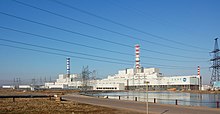Smolensk Nuclear Power Plant
| Smolensk Soviet Nuclear Power Plant | |
|---|---|
 |
|
| Country | Russia |
| Coordinates | 54°10′8.98″N 33°14′47.89″E / 54.1691611°N 33.2466361°ECoordinates: 54°10′8.98″N 33°14′47.89″E / 54.1691611°N 33.2466361°E |
| Status | Operational |
| Construction began | 1 October 1975 |
| Commission date | 9 December 1982 |
| Operator(s) | Rosenergoatom |
| Nuclear power station | |
| Reactor type | RBMK |
| Power generation | |
| Units operational | 3 x 1,000 MW |
| Units cancelled | 1 x 1,000 MW |
| Nameplate capacity | 3,000 MW |
| Capacity factor | 19.4% |
| Annual gross output | 5,093 GW·h |
Smolensk Nuclear Power Plant (Russian: Смоленская АЭС [![]() pronunciation ]) is a nuclear power station in Russia. It is located in the Smolensk region, in Desnogorsk province, approximately 100 km from Smolensk, 115 km from Bryansk and 320 km from Moscow. Smolensk Nuclear Power Plant is the biggest NPP in the Nechernozem region of Russia.
pronunciation ]) is a nuclear power station in Russia. It is located in the Smolensk region, in Desnogorsk province, approximately 100 km from Smolensk, 115 km from Bryansk and 320 km from Moscow. Smolensk Nuclear Power Plant is the biggest NPP in the Nechernozem region of Russia.
Smolensk NPP operates three RBMK-1000 reactors (1000 MW water-cooled graphite-moderated channel-type reactors). The plant was supposed to have four units but the construction of the 4th reactor was stopped in 1993 following the Chernobyl disaster.
All the units are equipped with emergency response systems, which can prevent release of radioactive material into the environment even in case of serious accident; for example breakage of pipes in the reactor cooling circuit. The reactor cooling circuit is housed in hermetic reinforced concrete boxes that can withstand a force of 4.5 kgf/cm2.
...
Wikipedia

